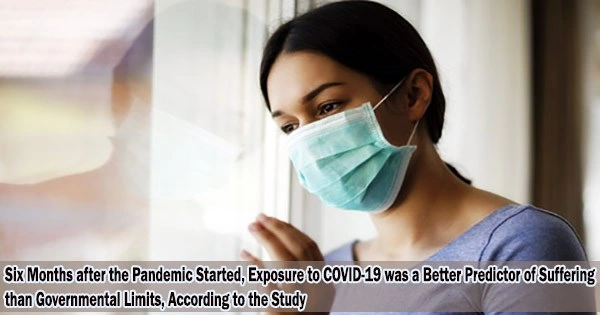A study published by the American Psychological Association found that state restrictions during the first six months of the pandemic were not associated with worse mental health, in spite of worries that stay-at-home orders and other government initiatives to stop the spread of COVID-19 would have a long-term negative impact on people’s mental health.
Instead, those who had direct contact with the virus and those who watched multiple hours of COVID-19-related media each day were more likely to develop anxiety, loneliness, and traumatic stress symptoms.
The findings were published in the journal Health Psychology.
“For the past several decades, our team has been examining the psychological impact of large-scale disasters on the population. In February 2020, we realized that the novel coronavirus, as it was called at the time, was likely to have an effect on the U.S. population in the months to come,” said senior author Roxane Cohen Silver, PhD, a distinguished professor of psychological science, medicine and public health at the University of California Irvine.
“We were particularly interested in the potential negative mental health effects of the associated restrictions placed on individuals throughout the pandemic, despite their potential for minimizing the spread of illness.”
The researchers surveyed a nationally representative sample of more than 6,500 participants at the start of the pandemic from March 18 to April 18, 2020, then surveyed almost 5,600 of the same participants approximately six months later from Sept. 26 to Oct. 16 to measure how their mental health and exposure to the virus changed over the course of the pandemic.
Because a strong predictor of distress in our study was personal bereavement knowing someone who had been very sick or died was far more stressful than the presence of state-level restrictions future waves of COVID-19 and other potential pandemics should be met by targeted interventions to prevent loss of life.
Rebecca Thompson
Respondents answered questions about symptoms of distress, loneliness and traumatic stress (acute and post-traumatic stress) they experienced in the prior week; whether they had contracted COVID-19; how many people they knew who had contacted the virus or died because of COVID-19; and how many hours on average they spent daily over the past week consuming pandemic-related news on traditional media, online news sources and social media platforms.
After that, the researchers compared their answers to information on the spread of COVID-19 and government mitigation measures in each respondent’s state, such as school closings and stay-at-home directives.
Over the course of the six months, participants generally felt more alone and global distress symptoms including despair and anxiety, but these symptoms were not significantly correlated with state-level restrictions, according to research.
As opposed to state-level restrictions (mask mandates, closures, etc.), case numbers, or death rates, personal experiences with COVID (degree of illness, losses), as well as the amount of media about the pandemic to which people were exposed, were better predictors of psychological symptoms.
The majority of participants who said they had COVID-19 in the first six months of the epidemic reported having poor mental health. Rebecca Thompson, PhD, the report’s first author and a postdoctoral scholar at UC Irvine, claims that discomfort, loneliness, and signs of traumatic stress were also strongly correlated with knowing someone who died as a result of COVID-19 or someone who had contracted COVID-19.
“Because a strong predictor of distress in our study was personal bereavement knowing someone who had been very sick or died was far more stressful than the presence of state-level restrictions future waves of COVID-19 and other potential pandemics should be met by targeted interventions to prevent loss of life,” Thompson said.
“Given this work, we would likely expect similar distress responses in future pandemics, highlighting the importance of public health initiatives to curb the spread of illness in our communities.”
Increased symptoms of distress over time were also strongly correlated with longer exposure to pandemic-related media coverage.
“For the first year of the pandemic, it was all bad news all the time,” Silver said. “Repeated exposure to that content was unlikely to have psychological benefits.”
In the case of future disasters or traumatic events, Silver recommends that individuals monitor the degree to which they immerse themselves in bad news (e.g., avoid “doomscrolling”) and consider specific times to check the news throughout the day.
“One can stay informed without becoming overwhelmed with a constant onslaught of bad news,” said Silver.
















